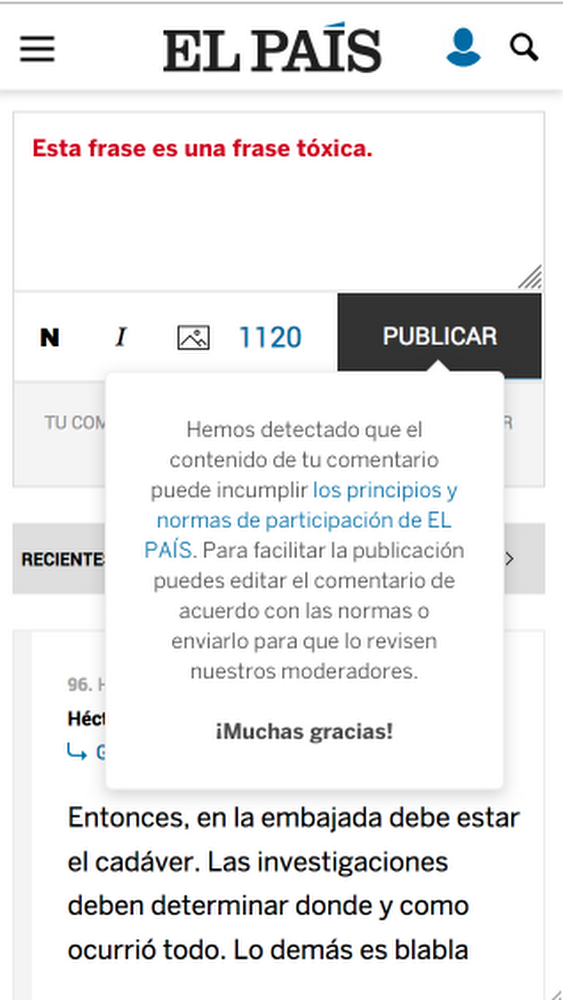This year, we’re celebrating innovation in journalism through a series of interviews with changemakers from across the news industry. Through the “Newsmakers” series, you’ll get to know a few of the journalists, newsroom leaders, researchers and technologists who are shaping the future of news. Today, we’re starting our series with Noemí Ramírez, the Chief Product and Customer Officer at PRISA Noticias, the parent company of EL PAÍS, the leading newspaper worldwide in Spanish. She leads the product, analytics and audience development areas at the company.
As an advocate for exploring the intersection of technology and news, Noemí has been instrumental in bringing Perspective, our AI-powered tool that aims to improve conversations in the comments section, to Spanish-language content. Before EL PAÍS, she was the Product Director at PRISA Innovation, a chief editor at El Mundo and worked for Investigative Reporters and Editors (IRE), the largest investigative journalism association in the U.S.
We spoke with Noemí about the power of technology in newsrooms and what qualities are key in the fast-paced world of journalism.
How did you first get started in journalism? If you weren’t a journalist, what would you do?
I always saw a clear connection between my background in information management and investigative journalism. As a result, I became very interested in the work done by IRE and decided to move to the heartland of America to earn a master’s degree in journalism as a Fulbright scholar at the Missouri School of Journalism. That’s where I had the opportunity to work both with IRE and NICAR(The National Institute for Computer-Assisted Reporting) in the area of Data Journalism—back in the late nineties it was called computer-assisted reporting. I got exposed to the impact that technology has in the storytelling and in the discovery of newsworthy stories.
I feel very attracted to professions that involve a strong level of research, testing hypotheses and supporting or discharging them based on factual evidence. I guess if I wasn’t working in journalism I would probably have pursued a career in disciplines as different as engineering, medical research or anthropology.
What’s one thing the industry should stop focusing on? What’s one thing that the industry should do more?
When comparing media with other industries, we in the media have a certain tendency to focus on what makes us unique. As good as it is to focus on what makes us stand out, there are many lessons to learn from other sectors, which is tied to developing a more collaborative mindset.
Probably the most obvious one is learning from the tech industry, which has a continuous pace of experimentation and an aim of speeding up delivery of products. Second of all, I am particularly interested in what drives consumers’ loyalty to powerful brands, both new and old, that put customers first. The media could learn from those companies, as well as from fundraising tactics led by NGOs.
What are some trends in technology for newsrooms that excite you?
The two usual suspects these days: AI and voice-activated interfaces. Machine learning algorithms take data journalism to a whole different level by allowing reporters to unveil the hidden connections between names, companies and other entities that might have been unnoticeable otherwise. There are also other kinds of applications of AI, such as helping manage readers’ conversational flows, identifying toxicity in their comments and contributing to a healthier and a more constructive public debate.

When someone types in a comment that’s similar to a toxic comment seen in the past, Perspective flags that it’s a potential violation of the site’s community guidelines before the commenter presses publish.
Voice interfaces open up exciting opportunities to explore new narratives and build products that are becoming increasingly integrated into our daily routines. These new products will be consumed in a vast array of connected devices, and that means we must develop a deep understanding of our users and create a truly customized experience for them.
What do you think is key to the future of your job and that of the industry?
Adapting to the rapidly changing environment, regaining the trust of the public, building a sustainable business model and getting control of that business model are probably the most important challenges that journalism is facing now and in upcoming years.
What would you say to a student thinking of entering journalism as a future career?
First, it’s important to have a realistic view of what’s going on. Almost every week we read about attacks on the press, traumatic layoffs, people reading misinformation instead of factual, verifiable stories and media companies struggling to consolidate different revenue streams. I do think, however, that there are also good reasons to believe that the role of independent and quality reporting is needed more than ever, and that there is a future for journalism.
Second, at a time of rapid change, the essential qualities of a good reporter—curiosity, critical thinking, knowing what to ask and search for—have not changed. In fact, digital media has made those qualities even more important. Journalism students need to learn how the new formats, narratives and new distribution players will help them to do their job: telling good, engaging stories to an increasingly large number of loyal readers.
Finally, bring an open, collaborative mind. Newsrooms have changed, and those that haven’t yet are on the brink of doing so. Nowadays, reporters work with product managers, audience analysts, engineers, video producers, visualization experts and data scientists. The industry is looking for people who combine product skills, technical understanding and business acumen and feel comfortable speaking those different languages.
Source : Newsmakers: Five questions with Noemí Ramírez of PRISA Noticias












